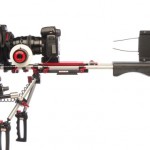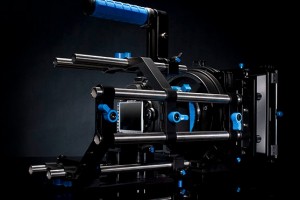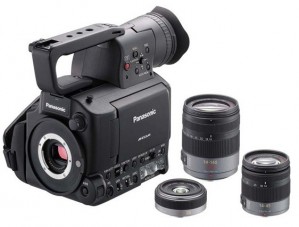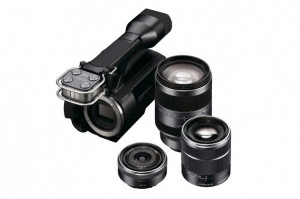
There has been a huge craze storming through the tech world for a while now: The ability of shooting high-end, high-definition video with a dSLR camera.
At first, it was a bit of a novelty, and people didn’t really know what the hell to do with it. Then, some photographers realised that it’s actually sort of nifty, and that you can achieve incredible results on a tidy budget. Then, finally it went all a bit silly, and a lot of videographers leapt on the bandwagon.
Personally, I think it’s a waste of time and a complete fad. I’ll tell you why.
What’s good about video with a dSLR?

There is a SLR camera in there, somewhere, but if you have to add several lengths worth of metal tubing to your camera to adapt it to be useful as a video camera, it is probably not a good sign.
Videographers have for many years been using dedicated video cameras, whether they are ones with high-quality lenses built in, or the high-end, interchangeable lens, 3CCD jobbies.
There are lots of reasons for using a high-end camera: The bigger sensor sizes make a huge difference to the quality of video you can record; multiple CCD makes sense to get better colour reproduction; and interchangeable lenses means that your camera body is perfect for any job.
The biggest problem with interchangeable-lens video cameras, however, is one of production volumes: By its nature, fewer people own video cameras (especially high-end video cameras) – and the kind of people who are willing to part with vast amounts of cash for the privilege of shooting with a top-of-the-line video camera are probably professionals who get paid for their work. Canon and Sony (who manufacture many of the high-end video cameras) know this, and price their products accordingly.
As such, the bodies are expensive, and the additional lenses you can buy for these lenses are obscenely expensive.
So, when the dSLR manufacturers started including video on their SLR bodies – first almost as an afterthought, later with some more planning and better integration – a lot of people perked up. SLR lenses can be had cheaply (a consumer SLR lens is often vastly superior to a much more expensive fixed-lens video camera lens, for a variety of reasons), and the expensive SLR lenses are on par with – if not superior to – their video counterparts, whilst being a lot cheaper.
Consequently, videographers creamed their proverbial pants, and ran out to buy camera bodies, whether full frame (Canon EOS 5D mk2 et al) or crop-frame (7D et al), and a whole load of different lenses.
Cinema-quality video output with home-video price tag? What could possibly be wrong about that?
The case against SLR video
In the hands of talented people – including the man who has become a bit of an icon of the SLR-as-video-camera movement, Philip Bloom, a lot of deeply impressive video content has been created. In the case of Bloom, however, we’re talking about an experienced videographer who understands better than most the advantages and downfalls of this sparkly new format; Whether through design or instinctively, he has found ways around the downsides.

I'm all for hacking your camera and computer equipment, but if you have to go to these lengths to make the equipment usable, I cannot help but think that there must be a better solution. And if there is none, there will be soon.
The biggest problem with moving images vs. still images is that you handle the camera in a fundamentally different way. Imagine, for a moment, that you are holding a camera. You’re probably holding your hands out in front of you, with your right hand supporting the camera body, your index finger poised over the shutter button. When you take a photo, you have to hold this pose, completely quietly, for 1/60th of a second. Click. Flash. Job done.
When you’re filming video, you’re essentially doing the same thing, but 30 (or 25 or 24, depending on what format you are video’ing in) times per second. Suddenly, the device which has evolved from being a photography creation device is no longer as comfortable.
Of course, crafty aftermarket equipment manufacturers came up with loads of solutions. There are geared wheels for pulling zoom and focus. There are eye-cups, grip straps, etc. And then it all got a little bit silly: You can buy an elaborate ‘DSLR-Marksman shoulder support’ rig, at the same price as you originally paid for your DSLR body; cages for your dSLR so you can strap lights and microphone rigs to it, etc.
To me, the fact that you have to buy a camera body and then have to invest the same (or more) amount of money again can mean one of two things: 1) it’s a very flexible and modular system; the best thing ever to have come to the world of digital videography. Or 2) the whole SLR form factor is simply not fit for purpose, and is a stop-gap until something better comes along.
I know that a lot of the SLR-Video crowd feel passionately that option #1, above, is correct, but I’m willing to bet that a lot of them know, in their heart of hearts, that what’s going on in the DSLR-video world is weird and not all that helpful: Your viewfinders suck. Sound recording is haphazard at best. The video files are inflexible.
So, what’s going to happen?

Panasonic recently launched this hideous-looking beast. It has one saving grace: it uses four-thirds camera lenses, which means there are lots of lenses available, from many different manufacturers.
To me, it seems that dSLR video has two advantages over other way of shooting video.
1) SLR cameras use SLR lens mounts. That means you can buy awesome lenses for not-a-lot-of-money.
2) SLR cameras have huge sensors, compared to their typical video equivalents, which gives a ‘look’ which is much closer to Hollywood than America’s Funniest Home Videos.
Don’t get me wrong: Both these points are golddust, and great reasons for shooting with SLR cameras. But it’s not going to last. Why?
The camera manufacturers are watching closely; I know that many of the prominent members of the SLR-video world have been approached by camera manufacturers, who want to talk to them about exciting new developments.

Sony is catching on too, with more affordable camcorders using consumer-grade (and potentially more exotic) lenses.
It’s only a question of time before Canon, Nikon and the rest of the gang cotton on, and start releasing proper video cameras – with a form factor that makes sense, proper audio capabilities, better file formats, decent viewfinders, and controls more finely attuned to the task at hand – whilst keeping the things we’ve grown to love about DSLR cameras: The lens mount and the sensor size.
I’m impressed by what people have been able to do with SLR cameras, and I admire the willingness to ‘hack’ the camera systems to be more suitable. As far as I’m concerned, it’s unfinished technology, poorly implemented, and not fit for purpose… But I’m willing to bet that’s going to change in the next 12 months.
